Paris to Monaro: Pleasures from the studio of Hilda Rix Nicholas
review by Jennifer Gall
Portraits are visual biography. Or are they? Hung in isolation or positioned in a gallery within a row of seemingly unrelated personalities, they can be reduced to a line-up of faces and bodies detached from their environment, their loved ones and their passions. In this situation we rely heavily on captions to provide a context. The success of the National Portrait Gallery’s exhibition: Paris to Monaro: Pleasures from the Studio of Hilda Rix Nicholas is firmly founded on curator Sarah Engledow’s inspired bringing together of art and artefacts to tell the story of an early 20th-century Australian artist and the world she created. It is not the whole story, leaving out the bleak war images the artist painted in her widowhood, and focusing on the woman rather than the career artist who won recognition in France and England. The exhibition celebrates Rix Nicholas as part of what Joanna Mendelssohn has described as ‘that glorious generation of early 20th century women artists’: those women whose parents were wealthy enough to both ensure that their daughters received an artistic education and then support them in their pursuit of an artistic career. The exhibition forms part of the 2013 Centenary of Canberra commemorative events and celebrates, in its own distinctive way, the international cultural currents flowing through Australian life at the time Canberra was founded and established.
Paris to Monaro provides a woman’s view of the lifestyle possible for middle class Australians in the early 20th century. Rix Nicholas’s art is very different from that of her female contemporaries: the modernists Margaret Preston, Grace Cossington Smith and Grace Crowley. Rix Nicholas’s paintings reflect a strongly feminine, personal response to the horror of the First World War, as she turned from the mass destruction around her to focus on beauty.
Born in Ballarat on 1 September 1884, Rix Nicholas’s life spanned a period of social and technological revolution. Her migrations from Australia to Europe and home again are reflected in the layout of the exhibition. As she travelled, the artist alternated between drawing, figuration, painting and landscape, building an impressive portfolio. The artworks and objects in the exhibition document the events of her life: the first part concentrating on her early days as an art student, her European tour, art classes at the New Art School in London, tuition at the Académie Delecluse and the Grande Chaumière, discovery of exotic Morocco, her tragically short five-week marriage to Major George Matson Nicholas, widowhood, and her return to Australia. The exhibition then focuses on her experiences in Australia, her second marriage to Edgar Wright and her life at Knockalong, a property near Delegate on the Monaro Plain, where she created a studio. The connection between Rix Nicholas’s later paintings with those of the younger artist is important and there is a satisfying feeling of completion as one leaves the exhibition space. Rix Nicholas’s palette – cool blues, teals, greys, corals and lemons with vibrant dashes of orange – harmonises the look of the exhibition and, together with her strongly illustrative technique, reinforces the evocation of an idealised world.
The arresting self-portrait Mrs George Matson Nicholas, c. 1917 is immediately engaging. Begun when she was a young wife, the portrait was completed following the death of her husband. In the aftermath of tragedy the act of drawing enabled the artist to remake her self- image and centre her artistic vision. A young, beautiful woman, elegantly dressed, appears to appraise the viewer as she critically analyses her own reflected image. The sparkling particles in the compressed black pastel enliven the work and, as the eye interrogates the image, the colours of the succeeding works glimpsed in our peripheral vision tempt us onward.
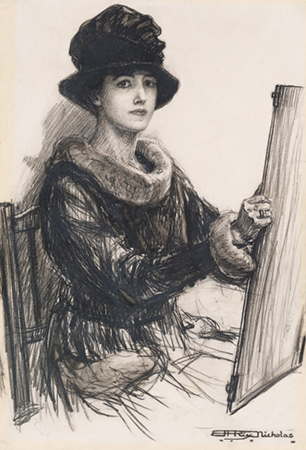
Bega Valley Art and Craft Society’s Permanent Collection, Bega Valley Regional Gallery
Moving through the exhibition there is a sense that we are discovering secrets as we investigate the intimate belongings – a small leather handbag, a packet of pins, a box of pencils, a notebook, letters and photographs – in the glass cases. The visitor shares Engledow’s sense of excitement, described in the catalogue, on her first visit to Rix Nicholas’s studio at Knockalong. Sketches executed in art classes in the mid-1920s convey a sense of immediacy and provide examples of how cleverly Rix Nicholas used line to capture spontaneity. A series of sketches for costumes, which she sewed for a fundraising event in London during the war, depict an imagination linked to a practical mind. Throughout her life, Rix Nicholas valued dress-ups and festivities as an antidote to the darker trials she faced. Creativity was her salvation.
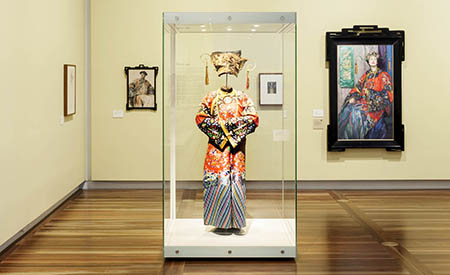
National Portrait Gallery
Morocco held a great fascination for Rix Nicholas and she visited there several times before the war. The portrait of the young man Hamido has particular poignancy in its representation of an uncommon connection between people of two radically different cultures. In this series of street scenes we see Rix Nicholas developing her ability to illuminate her paintings from within – a distinctive handling of light that remained her hallmark. Here, too, the display of contextual objects provides an added dimension to the artworks. Displayed in a glass case are the items described in Rix Nicholas’s record of a shopping excursion:
There were streets of shops where they were making many coloured shoes for women, embroidered in gold and silver thread and gorgeous silks. We could not resist and each bought a pair. Then there were streets of clothing shops – old and new and I found a flame coloured woman’s waistcoat embroidered in gold and silver braids …we returned to the hotel thrilled to the last fibre.
The centrepiece of the exhibition is the re-creation of the Knockalong studio, designed by Rix Nicholas in French Provincial style and completed in 1930, representing the fulcrum in her artistic career. Here are the furniture from her travels and the trunk from which spill golden embroidered rainbow cloths. The visitor can contemplate, as Rix Nicholas did, the sun-bleached paddocks outside the windows as they are reproduced as part of the photographic mural. There is a thrill in viewing the exact costumes that are depicted in the paintings exhibited: the golden medieval gown featured in a self-portrait of the artist, and the fairy crown and wand worn by her little boy at his birthday party long ago, with the very 78 RPM record that was played to entertain the guests. Textiles, embroidered clothing, ceramics, exotic shoes and jewellery that Rix Nicholas collected on her travels evoke an enchanted fairytale aesthetic. And, indeed, here are the artist and her husband, Edgar Wright, photographed in costume as the King and Queen of Hearts. The Fleece (1944), depicting Wright in his work clothes, is a nice counterpart to these fanciful photographs, capturing the calm confidence of a farmer who is master of his estate.
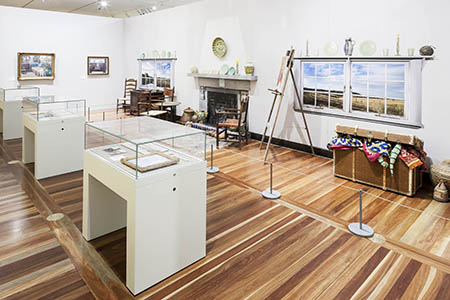
National Portrait Gallery
The atmosphere in the exhibition accurately reflects the subtitle: Pleasures from the Studio of Hilda Rix Nicholas. In each of my four visits it was clear that the visitors were embracing the ‘pleasure’ principle and I have seldom heard such a vocally appreciative, engaged group of patrons. One woman turned to me and said happily, ‘You feel you know her don’t you!’
The curator invites the viewer to experience the rich sensuality at the heart of Rix Nicholas’s artistic creativity and the secure, protected world in which she nurtured her artistic talent. This luscious visual spectacle is the great appeal of the exhibition. A pretty profusion of artefacts and paintings depicting the dress-ups and costume parties created by Nicholas may appear to represent a superficial life devoid of struggle, but this judgement is simplistic. This is a story of resilience, the narrative of an artist who recreated herself in response to tragedy.
The artistic oasis that Rix Nicholas created sprang from deep loss. Captions ensure that we are made aware of these deaths, but it is the absence of depictions of suffering in the portraits of strong, vibrant young soldiers, confident pastoralists and strong self-possessed women which suggests that hers was a spirit seeking to heal itself through representation of the idealised and the beautiful. Rix Nicholas used her art to clothe the pain of grief and create something new and lustrous. She painted ordinary people as heroic figures in the Australian landscape – a landscape unmarked by prolonged bombardment and brutal bloodshed.
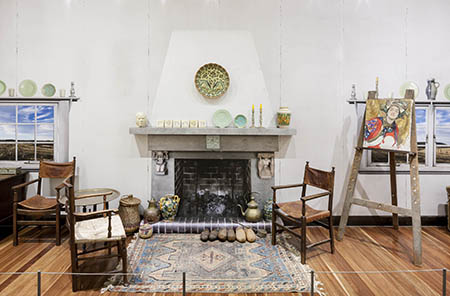
National Portrait Gallery
Trained in her youth by Frederick McCubbin (1902–05) at the National Gallery School in Melbourne, Rix Nicholas absorbed the senior artist’s preoccupation with representing figures within the Australian landscape. But in paintings such Les Fleurs Dédaignées (1925) and The Bride: June Ashley-Wilson (1938) the artist goes beyond pure representation to depict emotional turmoil beneath decorative appearance. Women models in the Australian paintings of the 1930s and later often wear ambivalent or disdainful expressions in marked contrast to the sunlight filled landscapes and ornate interiors they inhabit. There is much going on beneath the surface of the façade they offer the casual viewer.
Rix Nicholas’s portraits of her son Rix in 1933 form a touching series of drawings. As in the drawings executed in the 1920s, we see the skilful accuracy of the artist to capture the essence of her lively model’s personality in her agile, unfaltering line. Giving birth to her son at age 46 must have seemed like a miracle to Rix Nicholas, and she devotedly recorded his early years, evidenced in the great number of artworks in which he features.
There are intriguing mysteries contained in the portraits: who was the ‘youth’ – male or female – depicted in Retour de la Chasse (1911) and photographed with Rix Nicholas? Why did she choose to portray the model/prostitute in the exceptional painting Les Fleurs Dédaignées in this specially created costume? What kind of friendships existed between the artist and these very different subjects? In her later portraits of young women, on horseback or walking, working or relaxing in the Australian landscape, their strong bodies are defined by the assertive sunlight. They are often isolated figures, and one wonders about the artist’s own feelings of loneliness. For all the detail provided in the exhibition, there is still much that remains hidden about Rix Nicholas’s inner life. One hopes that, inspired by this exhibition, an exhaustive, new biography might be written. John Pigot’s book Hilda Rix Nicholas: Her Life and Art is now 13 years old and there is more to add to her story.
A carefully produced catalogue, which contains images of almost every item on display and a succinct, informative text aimed at a general audience, supports the exhibition. The size of the book is large enough to present the images well and remain more manageable to read on the move than larger format catalogues. It complements existing publications about Rix Nicholas by providing images of the personal effects, family photographs and the studio at Knockalong that provide a context for her portraits.
An online learning resource offers a clear, well-written guide suitable for children from late primary school age to college students. The opening exercise, requiring the student to ‘Create a still-life of objects that are special to you or hold some memories such as travel or significant events’, is one that older visitors would be inspired to attempt as well. Images of the artworks are generously available on the website to revisit and contemplate after visiting.
Activities based on making replicas of Rix Nicholas’s whimsical minikins (stuffed dolls dressed as fairy-tale characters) were popular with smaller children when I visited. There were copious quantities of art materials and the work tables looked extremely inviting with space to park a push-chair and assist children with the creative process. More than one adult patron looked wistfully at the craft activities, fighting the temptation to become immersed in the childhood space of play and imagination. Perhaps it is this capacity for pure delight, reflected in the assemblage of Rix Nicholas’s belongings, that transports visitors.
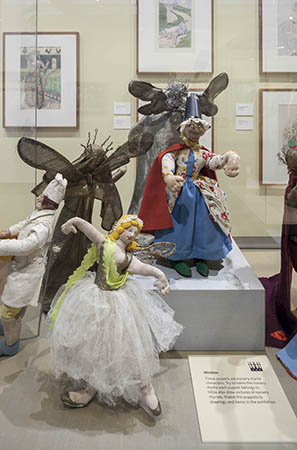
National Portrait Gallery
Despite the comprehensive collection of personal effects, both intimate and purely decorative, the private Hilda Rix Nicholas remains indefinable and fascinating. We walk away enriched by the colours and textures of a life repeatedly re-created out of the trials of adversity.
Jennifer Gall is the manager of research programs at the National Film and Sound Archive, and a visiting fellow at the School of Music, Australian National University.
| Exhibition: | Paris to Monaro: Pleasures from the Studio of Hilda Rix Nicholas |
| Institution: | National Portait Gallery |
| Curator: | Sarah Engledow |
| Exhibition design: | Tim Moore |
| Graphic design: | Brett Wiencke |
| Venue/dates: |
National Portrait Gallery, Canberra, 31 May 2013 – 11 August 2013 |
| Exhibition catalogue: | Sarah Engledow, Paris to Monaro: Pleasures from the Studio of Hilda Rix Nicholas, National Portrait Gallery, Canberra, 2013, ISBN 9780987073594 (hardback) |
| Exhibition website: | Paris to Monaro |
